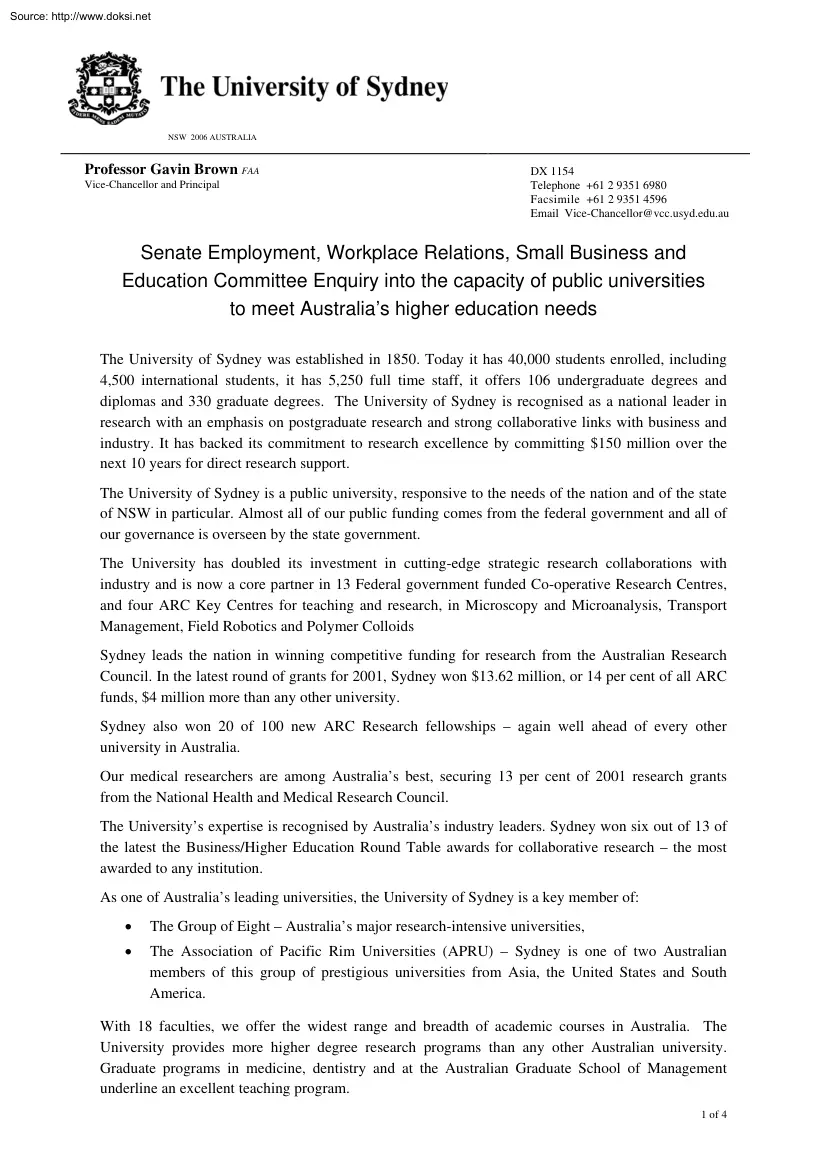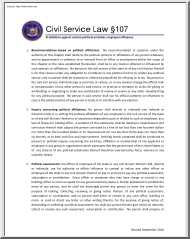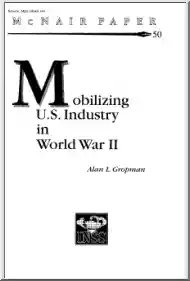Please log in to read this in our online viewer!

Please log in to read this in our online viewer!
No comments yet. You can be the first!
What did others read after this?
Content extract
Source: http://www.doksinet NSW 2006 AUSTRALIA Professor Gavin Brown FAA Vice-Chancellor and Principal DX 1154 Telephone +61 2 9351 6980 Facsimile +61 2 9351 4596 Email Vice-Chancellor@vcc.usydeduau Senate Employment, Workplace Relations, Small Business and Education Committee Enquiry into the capacity of public universities to meet Australia’s higher education needs The University of Sydney was established in 1850. Today it has 40,000 students enrolled, including 4,500 international students, it has 5,250 full time staff, it offers 106 undergraduate degrees and diplomas and 330 graduate degrees. The University of Sydney is recognised as a national leader in research with an emphasis on postgraduate research and strong collaborative links with business and industry. It has backed its commitment to research excellence by committing $150 million over the next 10 years for direct research support. The University of Sydney is a public university, responsive to the needs of the nation
and of the state of NSW in particular. Almost all of our public funding comes from the federal government and all of our governance is overseen by the state government. The University has doubled its investment in cutting-edge strategic research collaborations with industry and is now a core partner in 13 Federal government funded Co-operative Research Centres, and four ARC Key Centres for teaching and research, in Microscopy and Microanalysis, Transport Management, Field Robotics and Polymer Colloids Sydney leads the nation in winning competitive funding for research from the Australian Research Council. In the latest round of grants for 2001, Sydney won $1362 million, or 14 per cent of all ARC funds, $4 million more than any other university. Sydney also won 20 of 100 new ARC Research fellowships – again well ahead of every other university in Australia. Our medical researchers are among Australia’s best, securing 13 per cent of 2001 research grants from the National Health and
Medical Research Council. The University’s expertise is recognised by Australia’s industry leaders. Sydney won six out of 13 of the latest the Business/Higher Education Round Table awards for collaborative research – the most awarded to any institution. As one of Australia’s leading universities, the University of Sydney is a key member of: • The Group of Eight – Australia’s major research-intensive universities, • The Association of Pacific Rim Universities (APRU) – Sydney is one of two Australian members of this group of prestigious universities from Asia, the United States and South America. With 18 faculties, we offer the widest range and breadth of academic courses in Australia. The University provides more higher degree research programs than any other Australian university. Graduate programs in medicine, dentistry and at the Australian Graduate School of Management underline an excellent teaching program. 1 of 4 Source: http://www.doksinet The
student/staff ratio of 15:1 is the most favourable of all universities in NSW, Victoria or Queensland and is well below the national average (18.1) Sydney attracts the largest number of first preference applications and offers more places to students with a UAI over 90 than any other NSW university Among our many outstanding students, two Sydney students won 2001 Rhodes Scholarships, bringing to 107 the number of University of Sydney Rhodes Scholars since 1904; four Sydney postgraduate students won 2001 Fulbright Scholarships, more than any other Australian university; and Nicholas Vine, Masters student in music, won the 2001 Harvard Club Menzies scholarship to complete his PhD at Harvard. These achievements look impressive and, indeed, we boast of them wherever possible, but they mask a much sadder story in that they have been enabled by staff members who have been pushed to the limit by reduced resources and increased demands. This comes at a time when their peers in many other
countries are benefiting from a national commitment to the importance of strong and competitive universities to the economic and social well-being of the nation. At this moment every Australian university is doing it tough. The basic problem is, of course, a matter of resources. Government funding to universities for general operating purposes has been cut by 6% in real terms since 1996. Moreover, there has been very little additional provision for necessary salary increases in that period. The resulting resource gap is commonly estimated at 15% That means we have had to find savings or raise additional income to cover a loss of capacity of over one fifth. It is sometimes argued that any salary increases are our own wilful fault, but we are the ultimate knowledge industry, our greatest asset lies in our staff − both those directly engaged in teaching and research and those whose work provides the necessary support for those core activities and their skills are portable and tradeable
and internationally sought after. The quality of the experience we can provide for our students must deteriorate, as will be obvious from many student submissions, yet they have suffered increased charges for HECS. I applaud the HECS scheme for its deferred payment option and recognise that all monies collected are dedicated to higher education. On the other hand, the University acts as a tax collector for government in an indirect relationship with the students. Each year part of our government support is attributed to HECS contributions raised from agreed load (with an adjustment made at year’s end). This fact distorts statistics about our income because this money is really a private contribution, and the students certainly feel that it is, substantially reducing the demand on the public purse. Separating student payments from the rest, we see that our direct government operating grant is only about 30% of our income. In the lead-up to the release of the Innovation Action
Statement there was some criticism of the G08 for our paper, “Research and Innovation: Australia’s Future”, because it made claims for what were seen as unrealistically high amounts. In fact, we argued that for Australia to remain competitive with OECD countries would require an additional $13 billion over five years, made up of $4.2 billion from business, $6.75 billion from the Commonwealth and $27 billion from other non-Commonwealth sources. These huge numbers would simply bring us back to the OECD average of R&D expenditure as a percentage of GDP. That average is over 2% but Australia has fallen from 17% in 1996 to 14% today. 2 of 4 Source: http://www.doksinet International comparisons make Australian University staff despair. At a recent APRU meeting we made comparisons of income per student across our member institutions. The Japanese (public and private) and U.S (private) universities deploy 6 times our income per student Those from Hong Kong and Singapore have
about 3 times the income per student of the University of Sydney. We are in a band with Seoul National and the University of Chile and still well ahead of Indonesia and Malaysia. Those quick comparisons should be adjusted for local purchasing power but are vivid reminders of our plight. Finland has made a commitment to have a minimum spending on R&D of 3% and many other countries are closer to 3% than the average 2%. In 1998 the United Kingdom announced a research funding increase of 1 billion pounds to which was added a further 400 million pounds from the Wellcome Trust. Further funding of £1 billion has been announced for 2002/03 and 2003/04 That is a funding boost in excess of $3.5 billion over three years The Canadian government has announced the Canada Research Chairs Program which will provide 2,000 new professorships over the next five years. For each chair the host university will receive both salary support of $200,000 (or $100,000, depending on which of the two tiers of
achievement applies) and also $125,000 infrastructure support per chair. The distribution will be according to how much federal granting agency funding a university has received, so they will go on a competitive basis to the leading Canadian research universities. I cannot resist remarking that the Australian government recently decided to devalue by a factor of 2 the significance of success in national competitive research grants when allocating our research quantum. The National Science Foundation budget in the US was increased by 7.1% in 1999 and 69% in 2000 Between 1982 and 1989 there were 37 information technology patents from Australia registered in the US. That compared with 53 IT patents from Israel, 12 from Taiwan, 4 from South Korea and 1 from Singapore. Between 1992 and 1996 everybody improved Australia moved from 37 to 80, Israel moved from 53 to 258, Taiwan from 12 to 1,007, South Korea from 4 to 1, 629 and Singapore from 1 to 82. I suppose that none of this would really
matter, except to those of us who have committed our lives to the universities, if it weren’t that Universities are crucial to the national well-being. In a world shrinking as a result of technological advance, there is a thirst from industry for highly-trained personnel, there is a need for research where commercialization is so fast that patents may be less important than speed to market, there is a demand for greater access to higher education and it is more difficult to reassert the traditional values which still matter – the creation of a humane society and the pursuit of pure intellectual enquiry. These pressures have been evident for many years and, for many years, most academics were in denial. The reality of operating in some ways as a business, as a service industry moreover with many clients – the students, employers, the public – was too threatening for many to contemplate. We should have great sympathy for that position. If a highly talented individual traded
personal wealth for intellectual freedom and later was required to be an entrepreneur on behalf of a low-paying university, can we blame them for unease? Today it is clear that a university must function as an efficient business enterprise, but that alone would be failure and I have a deep belief that this must only be a means to an end. The aim should be of the highest moral purity but that requires effective income generation for the university and wealth generation for the wider community. 3 of 4 Source: http://www.doksinet The serious danger is that there develops a cadre of professional managers who are separate from the academic spirit of the university. In a sense, one could reconstruct a derivative of the old model Reconceptualise deans, presidents, vice-chancellors as non-academic managers, have them cross the floor to join the traditional professional administrators and envisage the professors as a specialised academic team within the workforce they supervise. Such an
“us-and-them” model will surely be doomed. At the risk of appearing less than optimally efficient we must incorporate the values of academic scholarship in all our major decisions and that requires wide consultation and the building of trust. I do not even know the words which would adequately describe the new form of ‘business-oriented collegiality’ which we must invent, but I like to think that in my university we have made some progress towards developing it. Certainly the important measures for our core activities, research and teaching, show strength and growth. Everyone agrees that change and modernisation are desirable but there are widely differing interpretations of what should be done. It is my firm belief that the most important recipe for university management success is to recruit the best possible people and give them a loose framework in which to operate with the maximum of space and autonomy. There must, of course, be accountability, but it is of no value to
introduce control mechanisms which stifle activity. At the University of Sydney we are trying very hard to create a freer but equally responsible environment. Summary Points 1. In the Australian context the University of Sydney is fulfilling its leadership mission. 2. By international comparisons Australian universities are severely underfunded for their core activities. 3. By international comparisons Australia severely underfunds R&D. 4. Australian students already make a significant private contribution to our public universities and the HECS scheme, despite its benefits, is described in a way which disguises this fact. 5. Staff, academic and general, are fundamental to our knowledge industry. They are underpaid 6. Income generation by universities is necessary and should be encouraged. Regulation is necessary to ensure accountability and freedom is necessary to ensure performance. 4 of 4
and of the state of NSW in particular. Almost all of our public funding comes from the federal government and all of our governance is overseen by the state government. The University has doubled its investment in cutting-edge strategic research collaborations with industry and is now a core partner in 13 Federal government funded Co-operative Research Centres, and four ARC Key Centres for teaching and research, in Microscopy and Microanalysis, Transport Management, Field Robotics and Polymer Colloids Sydney leads the nation in winning competitive funding for research from the Australian Research Council. In the latest round of grants for 2001, Sydney won $1362 million, or 14 per cent of all ARC funds, $4 million more than any other university. Sydney also won 20 of 100 new ARC Research fellowships – again well ahead of every other university in Australia. Our medical researchers are among Australia’s best, securing 13 per cent of 2001 research grants from the National Health and
Medical Research Council. The University’s expertise is recognised by Australia’s industry leaders. Sydney won six out of 13 of the latest the Business/Higher Education Round Table awards for collaborative research – the most awarded to any institution. As one of Australia’s leading universities, the University of Sydney is a key member of: • The Group of Eight – Australia’s major research-intensive universities, • The Association of Pacific Rim Universities (APRU) – Sydney is one of two Australian members of this group of prestigious universities from Asia, the United States and South America. With 18 faculties, we offer the widest range and breadth of academic courses in Australia. The University provides more higher degree research programs than any other Australian university. Graduate programs in medicine, dentistry and at the Australian Graduate School of Management underline an excellent teaching program. 1 of 4 Source: http://www.doksinet The
student/staff ratio of 15:1 is the most favourable of all universities in NSW, Victoria or Queensland and is well below the national average (18.1) Sydney attracts the largest number of first preference applications and offers more places to students with a UAI over 90 than any other NSW university Among our many outstanding students, two Sydney students won 2001 Rhodes Scholarships, bringing to 107 the number of University of Sydney Rhodes Scholars since 1904; four Sydney postgraduate students won 2001 Fulbright Scholarships, more than any other Australian university; and Nicholas Vine, Masters student in music, won the 2001 Harvard Club Menzies scholarship to complete his PhD at Harvard. These achievements look impressive and, indeed, we boast of them wherever possible, but they mask a much sadder story in that they have been enabled by staff members who have been pushed to the limit by reduced resources and increased demands. This comes at a time when their peers in many other
countries are benefiting from a national commitment to the importance of strong and competitive universities to the economic and social well-being of the nation. At this moment every Australian university is doing it tough. The basic problem is, of course, a matter of resources. Government funding to universities for general operating purposes has been cut by 6% in real terms since 1996. Moreover, there has been very little additional provision for necessary salary increases in that period. The resulting resource gap is commonly estimated at 15% That means we have had to find savings or raise additional income to cover a loss of capacity of over one fifth. It is sometimes argued that any salary increases are our own wilful fault, but we are the ultimate knowledge industry, our greatest asset lies in our staff − both those directly engaged in teaching and research and those whose work provides the necessary support for those core activities and their skills are portable and tradeable
and internationally sought after. The quality of the experience we can provide for our students must deteriorate, as will be obvious from many student submissions, yet they have suffered increased charges for HECS. I applaud the HECS scheme for its deferred payment option and recognise that all monies collected are dedicated to higher education. On the other hand, the University acts as a tax collector for government in an indirect relationship with the students. Each year part of our government support is attributed to HECS contributions raised from agreed load (with an adjustment made at year’s end). This fact distorts statistics about our income because this money is really a private contribution, and the students certainly feel that it is, substantially reducing the demand on the public purse. Separating student payments from the rest, we see that our direct government operating grant is only about 30% of our income. In the lead-up to the release of the Innovation Action
Statement there was some criticism of the G08 for our paper, “Research and Innovation: Australia’s Future”, because it made claims for what were seen as unrealistically high amounts. In fact, we argued that for Australia to remain competitive with OECD countries would require an additional $13 billion over five years, made up of $4.2 billion from business, $6.75 billion from the Commonwealth and $27 billion from other non-Commonwealth sources. These huge numbers would simply bring us back to the OECD average of R&D expenditure as a percentage of GDP. That average is over 2% but Australia has fallen from 17% in 1996 to 14% today. 2 of 4 Source: http://www.doksinet International comparisons make Australian University staff despair. At a recent APRU meeting we made comparisons of income per student across our member institutions. The Japanese (public and private) and U.S (private) universities deploy 6 times our income per student Those from Hong Kong and Singapore have
about 3 times the income per student of the University of Sydney. We are in a band with Seoul National and the University of Chile and still well ahead of Indonesia and Malaysia. Those quick comparisons should be adjusted for local purchasing power but are vivid reminders of our plight. Finland has made a commitment to have a minimum spending on R&D of 3% and many other countries are closer to 3% than the average 2%. In 1998 the United Kingdom announced a research funding increase of 1 billion pounds to which was added a further 400 million pounds from the Wellcome Trust. Further funding of £1 billion has been announced for 2002/03 and 2003/04 That is a funding boost in excess of $3.5 billion over three years The Canadian government has announced the Canada Research Chairs Program which will provide 2,000 new professorships over the next five years. For each chair the host university will receive both salary support of $200,000 (or $100,000, depending on which of the two tiers of
achievement applies) and also $125,000 infrastructure support per chair. The distribution will be according to how much federal granting agency funding a university has received, so they will go on a competitive basis to the leading Canadian research universities. I cannot resist remarking that the Australian government recently decided to devalue by a factor of 2 the significance of success in national competitive research grants when allocating our research quantum. The National Science Foundation budget in the US was increased by 7.1% in 1999 and 69% in 2000 Between 1982 and 1989 there were 37 information technology patents from Australia registered in the US. That compared with 53 IT patents from Israel, 12 from Taiwan, 4 from South Korea and 1 from Singapore. Between 1992 and 1996 everybody improved Australia moved from 37 to 80, Israel moved from 53 to 258, Taiwan from 12 to 1,007, South Korea from 4 to 1, 629 and Singapore from 1 to 82. I suppose that none of this would really
matter, except to those of us who have committed our lives to the universities, if it weren’t that Universities are crucial to the national well-being. In a world shrinking as a result of technological advance, there is a thirst from industry for highly-trained personnel, there is a need for research where commercialization is so fast that patents may be less important than speed to market, there is a demand for greater access to higher education and it is more difficult to reassert the traditional values which still matter – the creation of a humane society and the pursuit of pure intellectual enquiry. These pressures have been evident for many years and, for many years, most academics were in denial. The reality of operating in some ways as a business, as a service industry moreover with many clients – the students, employers, the public – was too threatening for many to contemplate. We should have great sympathy for that position. If a highly talented individual traded
personal wealth for intellectual freedom and later was required to be an entrepreneur on behalf of a low-paying university, can we blame them for unease? Today it is clear that a university must function as an efficient business enterprise, but that alone would be failure and I have a deep belief that this must only be a means to an end. The aim should be of the highest moral purity but that requires effective income generation for the university and wealth generation for the wider community. 3 of 4 Source: http://www.doksinet The serious danger is that there develops a cadre of professional managers who are separate from the academic spirit of the university. In a sense, one could reconstruct a derivative of the old model Reconceptualise deans, presidents, vice-chancellors as non-academic managers, have them cross the floor to join the traditional professional administrators and envisage the professors as a specialised academic team within the workforce they supervise. Such an
“us-and-them” model will surely be doomed. At the risk of appearing less than optimally efficient we must incorporate the values of academic scholarship in all our major decisions and that requires wide consultation and the building of trust. I do not even know the words which would adequately describe the new form of ‘business-oriented collegiality’ which we must invent, but I like to think that in my university we have made some progress towards developing it. Certainly the important measures for our core activities, research and teaching, show strength and growth. Everyone agrees that change and modernisation are desirable but there are widely differing interpretations of what should be done. It is my firm belief that the most important recipe for university management success is to recruit the best possible people and give them a loose framework in which to operate with the maximum of space and autonomy. There must, of course, be accountability, but it is of no value to
introduce control mechanisms which stifle activity. At the University of Sydney we are trying very hard to create a freer but equally responsible environment. Summary Points 1. In the Australian context the University of Sydney is fulfilling its leadership mission. 2. By international comparisons Australian universities are severely underfunded for their core activities. 3. By international comparisons Australia severely underfunds R&D. 4. Australian students already make a significant private contribution to our public universities and the HECS scheme, despite its benefits, is described in a way which disguises this fact. 5. Staff, academic and general, are fundamental to our knowledge industry. They are underpaid 6. Income generation by universities is necessary and should be encouraged. Regulation is necessary to ensure accountability and freedom is necessary to ensure performance. 4 of 4




